| Web
and Book design,
Copyright, Kellscraft Studio 1999-2016 (Return to Web Text-ures) |
 (HOME)
|
|
"A Garden! The word is
in itself a picture, and what
pictures it reveals!" E. V. B.
COMPANION CROPS Mention is made only of
those flower
crops actually in bloom at the same time in the garden illustrated.
From this
garden, of thirty-two beds separated by turf walks, and with two
central
cross-walks and an oblong pool for watering purposes, practically all
yellow
flowers have been eliminated, and all scarlet as well. The early
columbine (Aquilegia chrysantha) and the
pale-yellow Thermopsis Caroliniana
are the only yellows now permitted, and these only to make blues or
purples
finer by juxtaposition. All yellow, orange, and scarlet flowers are
relegated
to the shrubbery borders; therefore, in speaking of companion crops in
this
garden, it will be understood that some of the greatest glories of
July,
August, and September are omitted. As far as I know, no one
has ever
suggested the growing of various varieties of gladiolus among the lower
ornamental grasses. This, if practicable culturally, should give many
delightful effects. A yellow gladiolus, such as Eldorado, among the
yellow-green grasses; the deep violet, Baron Hulot, or salmon-pinks,
among the
bluish-green. Stems of gladiolus must ever be concealed. This would do
it
gracefully and well. The two companion crops
of spring
flowers shown in cut are the early forget-me-not (Myosotis
dissitiflora), which presses close against the dark-red
brick of the low post, while the Heavenly Blue grape hyacinth (Muscari botryoides, var.), a rich
purplish-blue, blooms next it. Tulipa
retroflexa is seen in the foreground, and the buds of Scilla
campanulata, var. Excelsior, when the photograph, was taken
were about to open. After one day's sun the various bulbs and the
forget-me-nots made a most ravishing effect with their clear tones of
blue,
lavender, and lemon-yellow. I never tire of singing
the praises
of Tulipa retroflexa; it is among my
great favorites in tulips. And this
leads to the mention of that tulip, to me, the best of all for color,
known
under three names Hobbema, Le R๊ve, and Sara Bernhardt. No other
tulip has
the wonderful and unique color of this. If you possess a room with
walls in
delicate creamy tones, furnished with a little old mahogany, and are
happy
enough to be able on some fine May morning to place there two or three
bowls
full of this tulip, you will understand my enthusiasm. The color may be
described as one of those warm yet faded rose-pinks of old tapestry or
other
antique stuff; a color to make an artist's heart leap up. This is far
from the
subject, but these digressions must occasionally be excused. In small note-books
tiny calendars
sent each year by a seed-house to its customers, and in which it is my
habit to
set down on each Sunday the names of plants in flower I find the
following
were blooming on a day in May: Tulipa
retroflexa, early forget-me-not, Muscari
botryoides, var. Heavenly Blue; Scilla
campanulata, var. Excelsior; tulip Rose เ Merveille, Campernelle
jonquil, Narcissus Barri, var. Flora Wilson; Narcissus Poetaz, var. Louisa; Tulipa Greigi,
Iris pumila, var. cyanea
(a lovely variety, the blue of the sky), Phlox
divaricata, var. Canadensis (the
new variety of this, Laphami, is both
larger and finer), so beautiful back of masses of Alyssum
saxatile, or rock cress, both single and double, and Iberis
Gibraltarica.
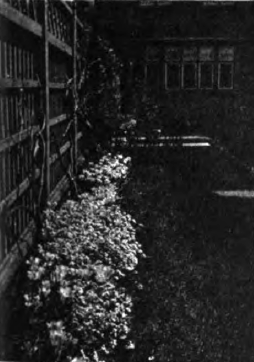
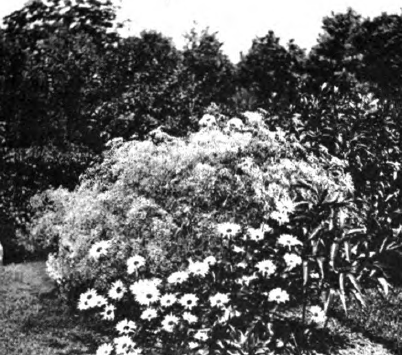 ARABIS AND TULIP DOUBLE GYPSOPHILA AND COTTAGE MAID SHASTA DAISY On the Sunday one week
earlier,
there were in full bloom last spring, tulips Chrysolora, Count of
Leicester
(the best double in tawny yellows), Couleur Cardinal, Thomas Moore,
Leonardo da
Vinci, narcissus Queen of Spain and Flora Wilson, Louisa, poet's
narcissus, Iris pumila (the common purple), and
tulips Vermilion Brilliant, Queen of Holland, Clusiana, Greigi,
Brunhilde,
Cerise Gris de Lin (another of the faded pinks in this case, however,
so
extreme that many gardeners would reject it), Gris de Lin, an
enchanting if
cold pink; Jaune เ-platie, violas and arabis, a bank of Munstead
primroses
(certainly the apotheosis of the English primrose, if so imposing a
word may be
used for so shy a flower). The arabis appears (facing page 28) with
Campernelle
jonquils in the near part, the darling tulip Cottage Maid blooming
brightly among
the arabis and making the loveliest imaginable spring bouquet. The
single
arabis I have now forsworn in favor of the new double variety, which is
far
more effective like a tiny white stock without the stock's stiffness
of habit
and quite as easy to grow and maintain. In the blossomy
photograph, facing
page 48, are found four or five companion crops of flowers, though that
was a
peculiar season in which this picture was made, when syringas bloomed
with
Canterbury bells! Here peonies and Canterbury bells make up the bulk of
bloom,
some young syringa bushes showing white back of them, and sweetbrier
covered
with fragrant pink to the right. Sweet-williams and pinks may be found
in the
foreground with rich rose pyrethrum, the sweet-williams of a dark
rose-red, in
perfect harmony with all the paler pinks near and beyond them. I may
say here
that, like most amateurs, I have a favorite color in flowers the pink
of
Drummond phlox, Chamois Rose, or, in deeper tones, of sweet-william
Sutton's
Pink Beauty, or the rosy-stock-flowered larkspur. When I say that such
and such
a flower is of a good warm pink, it is to the tones of one or the other
of
these that I would refer. On the date on which this
picture of
peonies was made there were to be found in bloom in my garden these:
larkspur, Thermopsis Caroliniana
(which I grow near groups of tall pale-blue delphinium,
and which makes a lovely color effect, adding lemon-colored spikes to
the
blue), sweetwilliams, Canterbury bells, peonies, Aquilegia
chrysantha, Achillea ptarinica, hardy campanula, pinks
both annual and hardy, foxgloves, roses, annual gypsophila, common
daisies. The
latter are valuable for masses of early white. I cut them to the ground
as soon
as bloom is over, when their low leaf-clumps are quickly covered by
overhanging
later flowers. The midsummer flower
crops are, by
all odds, the greatest in variety as they are in luxuriance. Some idea
of the
appearance of this garden in mid-July may be had in the top cut facing,
when
the flowers fully open are almost all either blue or white, except
toward the
centre of the garden, where delicate pink tones prevail, and the fine
purple
hardy phlox Lord Rayleigh blooms, giving richness to the picture and
forming a
combination of colors, blue and rich purple, which is especially to my
taste. The abundance of Gypsophila paniculata, var. elegans,
will be noted throughout the
garden, and just here may be recalled that delightful and suggestive
article by
Mr. Wilhelm Miller in "The Garden Magazine" for September, 1909,
advocating the use of flowers with delicate foliage and tiny blossoms
as aids
to lightness of garden effects, not to mention the new varieties of
such
flowers mentioned in the article, Crambe
orientalis, Rodgersia, and various unfamiliar spireas. 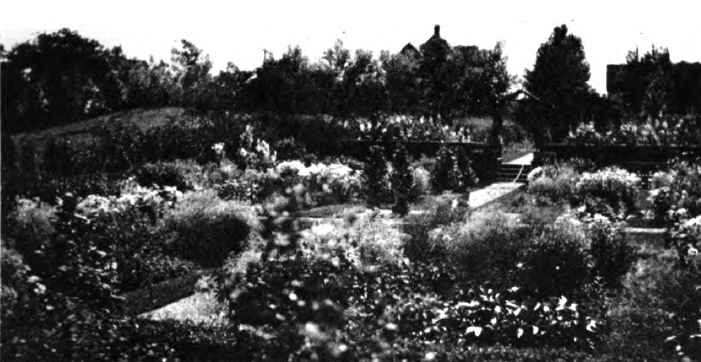 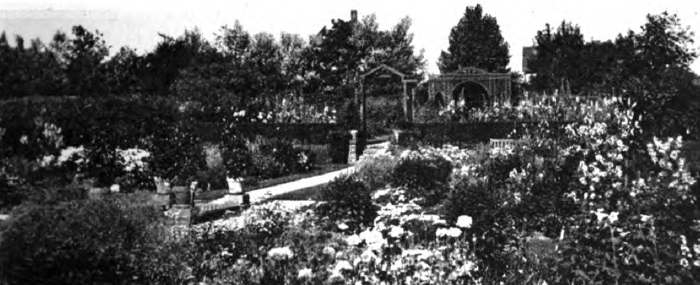  GYPSOPHILA AND LILIES IN THE GARDEN There is a whiter
gypsophila; there
is a grayer as well. The former is the variety flore pleno,
the latter the ordinary paniculata. They are both
tremendous acquisitions to the garden, as
their cloudlike masses of bloom give a wonderfully soft look to any
body of
flowers, besides making charming settings for flowers of larger and
more
distinct form, as in cut (page 28), where Shasta daisy Alaska is grown
against
the double gypsophila. Lilium longiflorum
is a companion crop of gypsophila, and I am much given to planting this
low-growing lily below and among the gray softness of the other. In
bloom when
the To continue with
companion crops:
perennial phlox E. Danzanvilliers, masses of palest lavender; Physostegia Virginica, var. alba; the
lovely lavender-blue Stokesia cyanea, Scabiosa Japonica,
sea-lavender (Statice incana, var.
Silver Cloud), stocks in whites and deep purples, the annual phloxes
Chamois
Rose and Lutea the latter so nice a tone of old-fashioned buff that
it is
useful as a sort of horticultural hyphen and a charming double
warm-pink
poppy, nameless, which raises its fluffy head above its blue-green
leaves from
July till frost, and brings warmth and beauty to the garden. Time was when I preferred
to see the
chamomile, or anthemis, spread its pale-yellow masses below the blue
delphinium
spikes; but I now prefer whites, or better still, rich purples or pale
lavenders, near, a closer harmony of color. One of the most
successful plantings
for boldness of effect is the one beyond the low hedge of the privet
ibota; a
detail is seen in cut facing page 86. This is of lemon and white
hollyhocks,
with thick, irregular groups of Lilium
candidum upspringing before them. Sufficient room is left between
the hedge
and the lilies to cultivate and to trim the hedge, which is but two
feet high.
And when these tall pale flowers open and both the rusty growth of
leaves at
the base of the hollyhock stalks, and the yellowing leaves of the lily
stems,
are hidden by the trim dark hedge, the effect from the garden itself is
surprisingly good. Numberless combinations of all these flowers, which
bloom at
the same time, suggest themselves, an infinite variety. Three plants
which
bloom in mid-July are the necessary and beautiful pink verbena, Beauty
of
Oxford, and the snapdragons in the fine new tones called pink,
carmine-pink,
and coral-red; also that exquisite flower, Clarkia
elegans, in the variety known as Sutton's double salmon, one of the
most
graceful and remarkably pretty annuals which have ever come beneath my
eye.
Love-in-the-mist blooms now, and the best variety, Miss Jekyll, is
exceedingly
pretty and valuable. A list of companion crops
for August
most naturally begins with perennial phloxes; in my case, Pantheon,
used very
freely; Aurore Boreale, Fernando Cortez (wonderful brilliant coppery
pink), a
very little Coquelicot, used in conjunction with sea-holly; white
phloxes von
Lassburg and Fianc้e, zinnia in light flesh tones, the good
lavender-pink
physostegia (Virginica rosea),
sea-holly, stocks, and dianthus of the variety Salmon Queen.
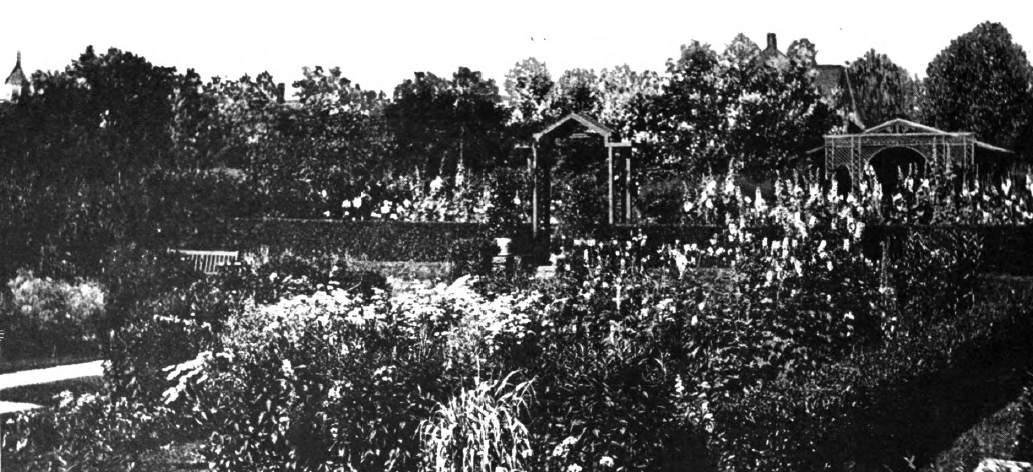 THE TIME OF LILIES AND DELPHINIUMS There is hardly space
left in which
to mention the flower crops which enrich September with color. But no
list of
the flowers of that month should begin with the name of anything less
lovely
than the tall, exquisite, pale-blue Salvia
patens. Called a tender perennial, I have found it entirely hardy;
and the
sudden blooming of a pale-blue flower spike in early autumn is as
welcome as it
is surprising. Second to this I place the hardy aster, or Michaelmas
daisy, now
to be had in many named varieties and forming, with the salvia just
named, a
rare combination of light colors. My hardy asters thus far have been
practically two, Pulcherrima and Coombe Fishacre, two weeks later; this
gives
me four weeks of lavender bloom in September and October. The
accommodating
gladiolus, which, as every one knows, will bloom whenever one plans to
have it,
is a treasure now. America, which has so much lavender in its pink, is
exceeding fair in combination with either of these hardy asters; and
when
spikes of the salvia are added to a mass of these two flowers of which
I have
just spoken, you have one of the loveliest imaginable companion crops
of
flowers. A prospective combination
not yet
tried but which I am counting upon this season is blue lyme grass (Elymus arenarius) with Chamois Rose Phlox
Drummondii below it, and back of
it gladiolus William Falconer. The lyme grass has much blue in its
leaves, and
so has the gladiolus; there should be excellent harmonies of both
foliage and
flower. Very lately, long since
the above
was written, a color combination most subtle and beautiful, a September
picture, has come to view: Salvia
farinacea, a soft blue-lavender, with clustering spikes of palest
pink
stock near it, very close to it, were the two subjects so perfectly
suited to
each other. Let me commend this arrangement as something rather out of
the
common, for I can hardly think this salvia is often met with in our
gardens.
And the use of a lovely but unfamiliar flower will bring with it a
certain
additional pleasure. |
